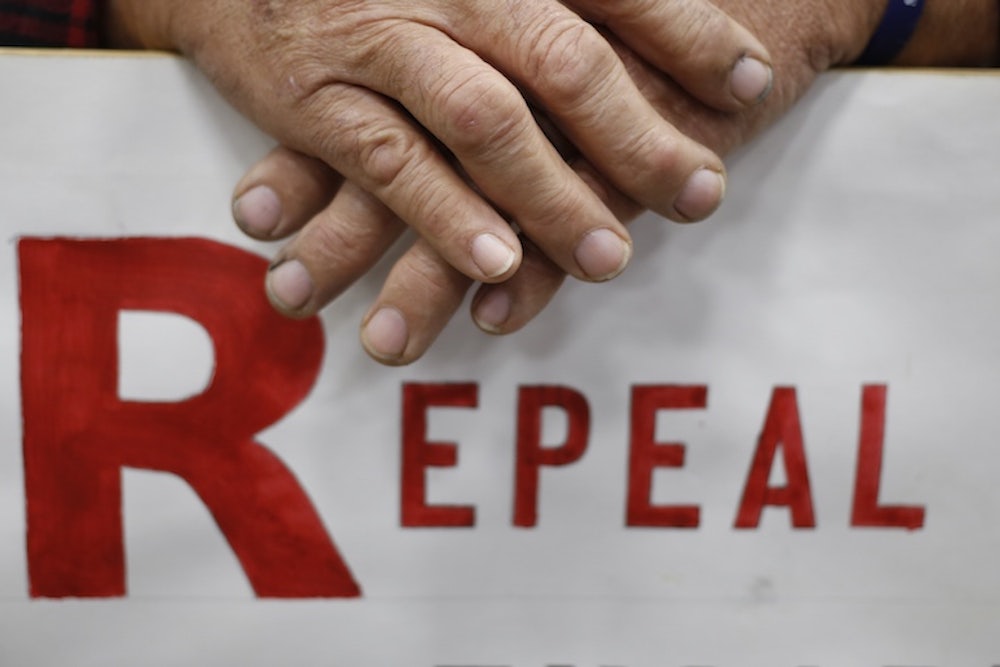When the Supreme Court decides whether to void Affordable Care Act subsidies in dozens of states that didn’t establish their own insurance exchanges, the most important word the justices will have to grapple with won’t be the word “exchange” or “established” or “state.” It will be the word “unambiguous.”
To quote Justice Antonin Scalia, the question before the justices (or at least the textualists among them) will be whether the words of the ACA statute, “in their context and with a view to their place in the overall statutory scheme,” unambiguously mean that the IRS can not and should never have subsidized health insurance in Healthcare.gov states.
That’s what the challengers in King v. Burwell claim. But if there’s any ambiguity—if the challengers’ reading of the law isn’t obviously the only reasonable way to read it—then those challengers should lose.
This so-called Chevron deference standard is an exceptionally high bar for the law’s opponents to clear. It helps explain the right’s strained and ongoing effort to rewrite the political and legislative histories of Obamacare by positing an alternate reality in which the bill’s authors either intentionally, or through sheer cluelessness, pledged to destroy insurance markets in states that didn’t collaborate with the ACA’s socialist health care scheme, and never told anyone.
It also requires conservative lawyers and judges backing the challengers to exhibit the kind of unsavory arrogance that conservative legal theorists have spent decades decrying as the root of liberal judicial activism. Limited interpretive theories, like textualism, are central to the commonly held conservative view that the Constitution demands a small government. Humility—or the pretense thereof—thus sits at the core of the conservative legal identity.
But humility is incompatible with sweeping declarations of certainty over highly contested matters. It is impossible at this point to support the ACA subsidy challenge and maintain that pretense.
The problem for ACA’s challengers is that unambiguity isn’t a flexible concept. If the ACA statute were truly unambiguous—if there were no reasonable way to read it other than as a law that clearly prohibits subsidizing insurance in states that don’t establish their own exchanges—then they would be able to present the statute to five or 10 or 50 people capable of interpreting it, and all of them, or nearly all of them, would agree.
Instead, among experts—including several federal judges—the challengers’ view is the minority view.
If a law's meaning is to be divined from its text, and the Chevron standard says you can only find for the challengers if the law's meaning is unambiguous, a conservative justice can’t find for them without implicitly rebuking or insulting all those other judges—including, most likely, all of the liberal justices on the Supreme Court. Otherwise, the argument becomes self-contradictory. It’s by definition ambiguous unless the many judges and scholars who’ve looked at this issue and rejected the challenge are daft or corrupted or engaging in some kind of conspiracy.
And you can’t suggest that without surrendering all pretense of humility—the very mantle of conservative jurisprudence.
In an exceptionally clean demolition of the challengers’ case, University of Michigan law professor Nicholas Bagley hinted at this basic contradiction. “[T]he aspect of their argument that troubles me the most [is] their unyielding conviction that they’ve identified the only possible construction of the ACA,” Bagley wrote in a brief for the Journal of Health Politics, Policy and Law. “Nowhere do they so much as acknowledge the possibility that maybe, just maybe, they’re wrong. That’s because they can’t admit to doubt. Because of the deference extended to agency interpretation, doubt means they lose. But their unwillingness even to acknowledge ambiguity reflects an important difference between legal advocacy and neutral interpretation.”
As it happens, there is a third plausible interpretation of the ACA’s subsidy provisions: That they’re unambiguous in the other direction. That the words of the ACA statute, “in their context and with a view to their place in the overall statutory scheme” unambiguously contemplate subsidies in every state.
I favor this interpretation in the same way that I interpret Magritte’s "Treachery of Images" to unambiguously depict a pipe. You might favor a murkier interpretation. But you'll only be misled into thinking that the pipe doesn’t exist at all if you focus on the text below it (“this is not a pipe”) in isolation. That’s more or less what the supporters of the King challenge are asking of you.

This article has been updated.
